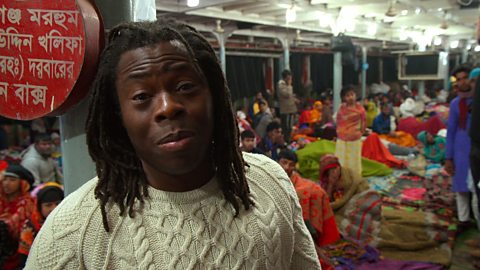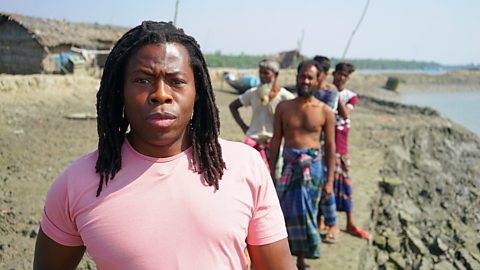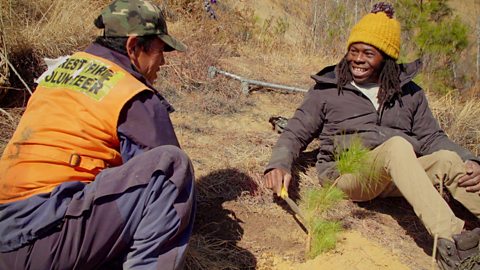Ade Adepitan visits a mountainous region of Bhutan to learn about the threat caused by melting glaciers.
ADE: Hi, IÔÇÖm Ade. IÔÇÖm in Bhutan, a very special country in the Himalayas. IÔÇÖm about to get into a helicopter to find out what climate change is doing to this incredible mountain range.
[MAP SHOWS LOCATION OF BHUTAN]
[IN HELICOPTER] Here we go. This terrain is incredible!
PHUNTSHO: Yeah, only tiny villages and very small settlements along the riversides.
ADE: ItÔÇÖs so beautiful.
PILOT: [SUBTITLED] In the front of us we have the highest unclimbed mountain in the world.
ADE: Far as the eye can see is just mountain range. ItÔÇÖs amazing!
Bhutan is the highest country in the world. Its average elevation is more than 10,000 feet.
PILOT: [SUBTITLED] You'll see one of the glaciers coming up on the left-hand side.
ADE: There are hundreds of glaciers in Bhutan and tens of thousands across the Himalayas as a whole. Outside the polar regions itÔÇÖs the largest store of ice anywhere in the world. ItÔÇÖs why people call this the third pole. But even here on top of the world and far from civilisation, rising temperatures are having an impact.
PHUNTSHO: Glaciers are melting and it gives rise to formation of lakes ÔÇŽ and these glacial lakes are forming at a very fast rate.
ADE: How many of them are there?
PHUNTSHO: In Bhutan, altogether, we have around two thousand plus glacial lakes.
ADE: Warming temperatures have melted around a quarter of Himalayan ice in just the last few decades and the vast volume of melt water now pouring into new glacial lakes poses a major threat to the communities further down the valleys.
PHUNTSHO: These lakes are actually jammed by some very loose unconsolidated uh, debris kind of thing. If those loose materials fail or collapse then it releases a huge amount of water downstream. Then you can image the kind of damage that can cause downstream.
ADE: But the melting Himalayas donÔÇÖt just affect the villages downstream. This matters to all of us. The melted ice ends up in rivers and eventually in the sea. Meltwater from mountain glaciers around the world has caused as much as a third of global sea level rise.
This is the greatest consequence of climate change that you might never have heard of. Because weÔÇÖre so used to hearing about the ice in the North and South Poles melting. But whatÔÇÖs happening here should be just as worrying.
Video summary
Ade Adepitan visits Bhutan to witness the effects of rising temperatures on the glaciers there, and the danger this poses to the communities further down the valleys.
Bhutan is the highest country in the world. It has around 2000 glacial lakes, the result of melting glaciers. Rising temperatures have melted around a quarter of Himalayan ice in just the last few decades and the vast volume of meltwater could cause major damage. The melting ice in the Himalayas doesn't only affect local communities: the meltwater ends up in rivers and eventually in the sea. Meltwater from mountain glaciers around the world has caused as much as a third of global sea level rise.
This clip is taken from the 91╚╚▒Č Two series Climate change: Ade on the frontline.
Teacher Notes
Before watching the film
This film builds on studentsÔÇÖ understanding of climate change and its impact on different environments around the world. Students will ideally have a basic understanding of what a glacier is and does. However, this film could also be used to trigger an enquiry to find out more about glacial processes and how climate change is affecting them so dramatically.
It is useful to have first seen this film clip about climate refugees journeying to the crowded city of Dhaka, Bangladesh. You could explain that this film will reveal another part of the climate change puzzle.
You might explain to students before the film that it is filmed in Bhutan and ask them to say where this is and what kind of a place, they think it is. It could be helpful to then locate the country of Bhutan on a map before the film and show the high topography of the area, establishing that is it in the Himalayas and briefly discussing the topography and characteristics.
During the film
You may wish to stop at relevant points during this short film to pose questions and check understanding or wait until the end. Useful questions might include:
- What kind of terrain is this?
- How high are the mountains here? (an average elevation over 10,000 feet)
- What kind of settlements are found here and whereabouts in the landscape are they located?
- What is a glacier?
- What is a glacial lake?
- Why is this region referred to as the ÔÇśThird PoleÔÇÖ?
- How many glacial lakes are there in Bhutan? (more than 2000)
- What proportion of Himalayan ice has been lost in the last few decades? (a quarter)
- What is holding the water back in glacial lakes? And what will happen when this dam of loose material gives way?
- How does this contribute to sea level rise?
After watching the film, initially, you might want to watch it through again and perhaps ask students to actively take notes to some of the key questions. You could then ask students what the effects of melting glacial ice will be and who it impacts on.
You might discuss how the small settlements high up in Bhutan are at immediate risk from the large volumes of water released when the glacial dams give way; how agricultural communities downstream near the coast are affected as increased flooding destroys their homes and farms, and how the global community is affected because of sea level rise.
Following on from the film
You could ask students to use maps, writing and / or diagrams to explain the connection between climate refugees in Dhaka, flooded land in low-lying Bangladesh and glacial melt in the Himalayas.
ÔÇťMeltwater from mountain glaciers around the world has caused about a third of sea level riseÔÇŁ.
You could discuss this line from the film and some of the implications. Students could identify other areas in the world where glaciers are melting and consider feedback loops such as albedo loss. Students could research areas where ice melt is happening the fastest and explain why.
You might ask students to explain these problems and suggest feasible mitigation and adaptation strategies for the global population, and for people living with these problems at a local scale.
This short film is suitable for teaching KS3 and KS4 students. It can be used alongside the other Ade Adepitan films about climate change or watched on its own, but it particularly links with other clips about climate refugees in Dhaka, Bangladesh, tree planting in Bhutan, and land loss in rural Bangladesh. All the films build on studentsÔÇÖ understanding of climate change issues and enable them to make global connections.
This film supports the KS3 geography curriculum by investigating our changing climate, environmental and human impacts and interactions, how humans seek to manage environments sustainably, and how places connect. It also supports a regional study within Asia.
At KS4 this supports work on climate change and natural hazards, glaciation, work on changing coastlines and sea-level rise, and environmental management.
This clip could be used to support the delivery of geography to KS3 and KS4 students. Specifically, this topic appears in OCR, Edexcel, AQA, WJEC KS4/GCSE in England and Wales, CCEA GCSE in Northern Ireland and SQA National 4/5 in Scotland.
Climate refugees in Dhaka, Bangladesh. video
Ade Adepitan meets climate refugees in Bangladesh, who have been forced by rising sea levels to seek a new life in their capital city of Dhaka.

Rising sea levels in Bangladesh. video
Ade Adepitan travels to Bangladesh to find out how a combination of rising sea levels and extreme weather events is affecting life.

Planting trees in Bhutan. video
Ade Adepitan meets Sonam Phuntsho, who has planted more than one hundred thousand trees in Bhutan. Planting trees is one of the cheapest and most effective ways we have of tackling climate change.
